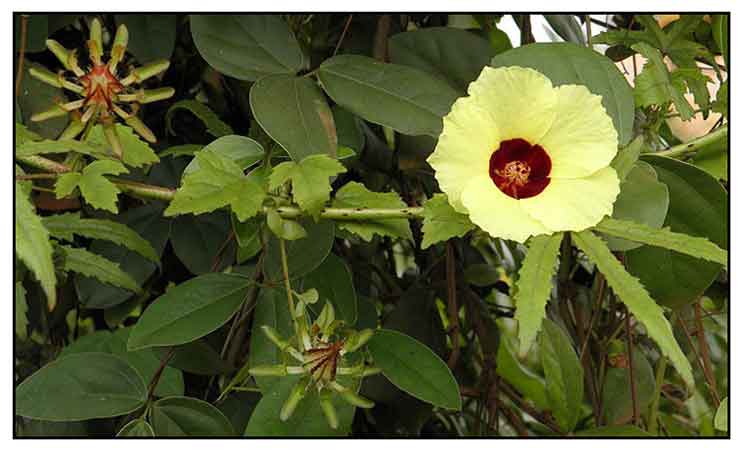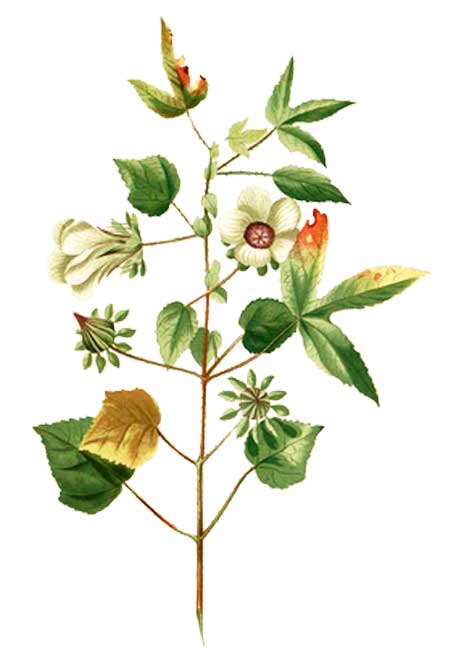|
 Botany Botany
Labuag is a weak-stemmed trailing plant covered with soft hairs and scattered prickles. Leaves are rounded, toothed, and deeply and palmately 3- or 5-lobed. Flowers are yellow with a dark red center. Capsules are hairy and ovoid. Seeds are downy.
Distribution
- Most islands and provinces throughout the Philippines in open grasslands, at low and medium altitudes.
- Certainly introduced.
- Also occurs in tropical Africa, Asia, and Malaya.
Constituents
- Seeds yield: oil, 13-17%, with a predominance of linoleic acid in the fatty acid component of the oil, followed by palmitic and oleic acids, and small concentrations of malvalic acid, sterculic, dihydrosterculic and epoxy acids.
- Essential oil from leaves
was dominated b y monoterpenes (34.1%) and sesquiterpene compounds (41.2%). Major oil constituents were ß-caryophyllene (12.9%), menthol (10.6%), methyl salicylate (9.7%), and camphor (9.2%), with significant amounts of germacrene D (5.5%), hexadecanoic acid (4.3%) α-humulene (4.0%), 1,8-cineole (3.0%) and methone (3.0%). (10)
Properties
- Rich in mucilage.
- Considered emollient,
febrifuge, laxative, abortifacient, pectoral, cardiotonic.
 Parts
used Parts
used
Leaves, stems, fruit, flowers, and roots.
Uses
Edibility / Culinary
- Acid leaves used for salads or as a pot-herb.
- In India, fruit and tender leaves used in curries.
- In Africa, leaves used as spinach.
Folkloric
- In Senegal, plant used as an emollient.
- Leaves used for cough.
- Zulus use a lotion or ointment of the stem and leaf as treatment for penile irritation; including venereal sores and urethritis. Infusion used as injection into the urethra and vagina for gonorrhea and other urethral inflammations.
- Decoction of leaves or roots used for skin complaints.
- In other traditional systems, used for paralysis, epilepsy, convulsions, pregnancy; as abortifacient.
- Leaf, root and fruit juice used for cutaneous parasitic infections.
- Roots used as febrifuge, laxative; for tumors and cancers.
- In Nigeria, leaf and fruit juice given to children for cough.
- In India, among the folklore herbalists and Tripuri medical practitioners, curry is made from its tender leaves and given to patients with jaundice. (3)
- In Bangladesh, leaves are used for intestinal disorders. Mucilaginous flowers used as emollient and pectoral. (9)
- In Africa, stems used for skin ulcers; leaves for anemia; decoction of leaves for adult dyspepsia; poultice of leaves for ulcers and boils; decoction of stems with leaves used for cough; paste of pounded roots applied to burns; leaves applied as dressing on wounds; infusion of leaves used as mouth wash for oral sores in children; heated leaves applied to boils and abscesses. (11)
- In Sierra Leone, infusion of leaves with Zingiber officinale or Ocimum gratissimum drunk for cough. (12)
- In Ayurveda, leaves, roots and fruits used for epilepsy, paralysis, pulmonary diseases, venereal diseases, parasitic infections, fever, edema, abscesses, snake bites. (13)
- In Indonesia, used by ethnic Sumari as antidiabetic herbal. (14)
- In Nigeria, infusion of leaves used internally for gonorrhea. (15)
Others
- Fiber: Plant yields a fiber of good quality. In Brazil, used as a substitute for jute.
- Provides material for roof thatching.
Studies
• Fatty Acid Composition: In a study of the fatty acid composition of seed oils of seven Hibiscus species of malvaceae, all contained 13-17% oil. Linoleic acid predominated in the component fatty acids of all oils, followed by palmitic acid and oleic acid. (1)
• Biodiesel Source: Study investigated the viability of using locally available vegetable seed oils to produce biodiesel. Two indigenous seeds - Hibiscus surattensis and Hibiscus sabdariffa were used in the study. Results suggest H. sabdariffa blend of 40:60 and H. surattensis blend of 30:70 can be recommended for use in diesel engines without any engine modifications. (6)
• Antidiabetic / Leaves: Study investigated the antidiabetic activity of ethanolic extract and fractions of leaves and fractions in invitro and in vivo models. Results showed the extract and fraction of HS leaves in vitro had no effect on α -glucosidase inhibition but exhibited antihypoglycemic effect on ethyl acetate and water fractions. (14)
Availability
Wild-crafted. |



 Parts
used
Parts
used

